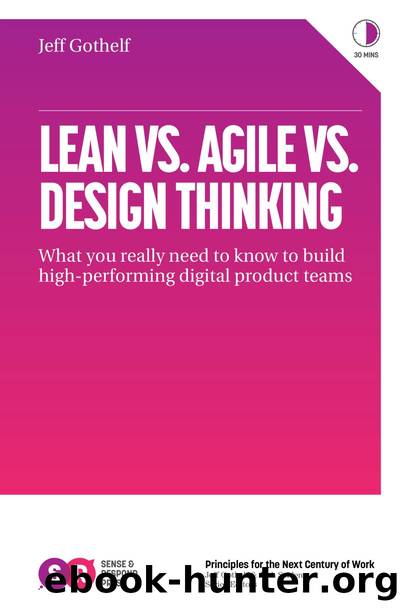Lean vs. Agile vs. Design Thinking by Jeff Gothelf

Author:Jeff Gothelf [Gothelf, Jeff]
Language: eng
Format: epub
ISBN: 978-0-9994769-0-1
Publisher: Sense and Respond Press
DESIGN THINKING
Agile helps us deliver work in regular cadences. Lean Startup helps us determine what to focus on. How, then, do we determine whether weâre actually working on something of value? Enter Design Thinking.
Popularized in the 1990s by legendary design agency IDEO (though around for decades before) and almost impossible to nail down in one definition, Design Thinking teaches teams to take an empathetic look at the customers they are building products for to understand the core needs being addressed. Then, through a series of facilitated brainstorming exercises, to come up with a set of solutions that not only meets those needs but is technically feasible and viable for the business. At least, thatâs how itâs supposed to work.
Despite the executive training courses at Stanfordâs d.School, 2.2 million presentations on Slideshare.net and, at the time of this writing, over 2600 results on Amazon for books on the topic, customer empathy is hard to find in large companies. Designers, brought in to infuse some âAppleâ-ness into the organization, are often left with the task of user advocacy. Buoyed by the frequency the phrase âdesign thinkingâ is used in these companies, these designers create workshops, brainstorming sessions, and design sprints and other activities designed (see what I did there?) to increase the teamâs empathy for the customer. The output of these sessions manifests as sketches, photos of Post-it note clusters, and whiteboard scribbles, discernible, if at all, only to the person who made them.
At best, these sessions help teams build a shared language and common sense of purpose for the upcoming project. At worst, theyâre perceived as a waste of time that could have been used to write code. Design Thinking practices are there for teams to use continuously to ensure projects stay on track and are adjusting properly to the learning derived from our Agile practices. However, most teams, having failed to arrive at an epiphany during their first brainstorming session, rarely employ these practices throughout the lifecycle of the project. The continuous nature of software, which should yield a cadence of continuous learning, is once again retrained on shipping bits to customers without the benefit of team-wide shared understanding of the core customer need.
Download
This site does not store any files on its server. We only index and link to content provided by other sites. Please contact the content providers to delete copyright contents if any and email us, we'll remove relevant links or contents immediately.
Hit Refresh by Satya Nadella(8855)
The Compound Effect by Darren Hardy(8513)
Change Your Questions, Change Your Life by Marilee Adams(7377)
Nudge - Improving Decisions about Health, Wealth, and Happiness by Thaler Sunstein(7244)
The Black Swan by Nassim Nicholas Taleb(6770)
Deep Work by Cal Newport(6563)
Daring Greatly by Brene Brown(6227)
Rich Dad Poor Dad by Robert T. Kiyosaki(6179)
Principles: Life and Work by Ray Dalio(5961)
Man-made Catastrophes and Risk Information Concealment by Dmitry Chernov & Didier Sornette(5650)
Playing to Win_ How Strategy Really Works by A.G. Lafley & Roger L. Martin(5506)
Digital Minimalism by Cal Newport;(5392)
Big Magic: Creative Living Beyond Fear by Elizabeth Gilbert(5353)
The Myth of the Strong Leader by Archie Brown(5239)
The Slight Edge by Jeff Olson(5200)
Discipline Equals Freedom by Jocko Willink(5157)
The Motivation Myth by Jeff Haden(5004)
Stone's Rules by Roger Stone(4859)
The Laws of Human Nature by Robert Greene(4774)
